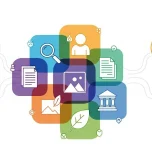An AI model might work perfectly on isolated objects in a clean dataset. But what happens when it is shown a crowded street, a packed warehouse shelf, or a complex microscope slide? Suddenly, the model’s accuracy plummets.
This is the “overlap challenge,” or occlusion. It is the real-world problem where objects of interest are partially or fully obscured by other objects. It is one of the most common and critical failure points for computer vision models, and solving it is the key to moving an AI from the lab to the real world.
Why does this matter? It is the difference between:
A medical AI that can segment overlapping cells to detect disease accurately.
A self-driving car that sees a pedestrian behind a pole or one that doesn’t.
A robotic arm that can identify the correct box from a jumbled pile.
This guide provides a practical framework for mastering “overlapping image annotation”. It covers the right strategies, the essential tool features, and the best practices for setting up a project for success, from initial guidelines to choosing the right partner.
Why Simple Annotations Fail: The Ambiguity of Overlapping Data
The core problem with overlapping objects is ambiguity. When two objects intersect, how does the AI model know where one ends and the other begins?
How Overlaps Confuse AI Models (And Lead to Wrong “Answers”)
Consider a scenario using simple bounding boxes. If two people are standing next to each other, an annotator might draw two distinct boxes. But what if one person is standing in front of the other? Should one giant box be drawn around both? Should two boxes that overlap be drawn?If an annotator draws overlapping boxes, the AI gets confusing signals. It can’t tell which pixels belong to which person. This ambiguity leads to models that give the wrong AI answers — they may count two objects as one, fail to detect the occluded object entirely, or lose all sense of object boundaries.
Instance vs. Semantic Segmentation: The Core of the Problem
To solve this, Machine Learning (ML) teams must move beyond simple classification or bounding boxes. The solution lies in instance segmentation.
- Semantic Segmentation: Answers “What stuff is in this image?” It assigns a class to every pixel (e.g., all pixels of all cars are colored “blue”).
- Instance Segmentation: Answers “What things are in this image?” It identifies individual object instances (e.g., “car 1” is blue, “car 2” is red).
To handle overlaps, instance segmentation must be used. This requires much more advanced annotation, typically precise polygons or masks that trace the exact outline of each object, even the parts that cannot be seen.
Where Overlap Annotation is Non-Negotiable
This isn’t just an academic problem. For many industries, solving occlusion is the primary challenge.
Use Case Spotlight: Autonomous Driving and Robotics
A self-driving car’s vision system faces a world of constant occlusion. It must track a pedestrian as they walk behind a bus, identify a cyclist partially hidden by a street sign, and understand the z-depth of cars in traffic. A small error in perception — confusing two objects, can be catastrophic.
The Critical Need for Medical Image Annotation
In digital pathology and radiology, the ability to segment overlapping and interconnected structures is essential for diagnosis. Imagine trying to count overlapping cells in a biopsy slide or trace a tumor that is entangled with healthy tissue and organs.This level of precision requires a highly specialized medical image annotation tool and expertly trained annotators who can use polygon or mask tools with pixel-perfect accuracy. A simple bounding box is useless here; the data’s value is in its granular precision.
Essential Features for Annotating Overlaps
A complex problem cannot be solved with a simple tool. If an annotation tool only makes boxes, the project will likely fail at annotating overlaps.
Beyond the Basics: Essential Tool Features for Occlusion
When evaluating a tool for this task, organizations should look for these specific features:
- Polygon and Mask Tools: The ability to draw complex, multi-point shapes is non-negotiable.
- Layer Management (z-index): The most critical feature. Annotators must be able to send an object “to the back” or bring one “to the front.” This allows them to trace the full outline of an object as if the object in front of it were transparent.
- Transparency Controls: A slider to make the selected polygon or mask partially transparent, so the annotator can see the object underneath it to trace its boundaries.
- Occlusion Flags: A simple checkbox or tag (e.g., is occluded) that the annotator can apply to an object. This adds valuable metadata for the model, teaching it to be more confident even when objects are partially hidden.
A Brief Look at Label Studio for Overlaps|Overlapping Image Annotation
When teams look for open-source options, they often find Label Studio. In a review of Label Studio, specifically for the task of annotating overlapping and occluded images, it is found to be a flexible and powerful choice. Its configurability and support for complex polygon and mask rendering make it a good technical starting point for a project. However, the tool itself does not solve the larger operational challenges of training, scaling, and quality assurance.However, the real challenge isn’t just if the tool can do it, but how it handles the workflow and quality control (QA) at scale. This is where many in-house projects struggle. A tool is only as good as the process and the people using it.
The Scalability Problem: In-House vs. Outsourcing Complex Projects
Annotating overlapping objects is not a simple, fast-moving task. It is slow, tedious, and mentally exhausting, making it prone to human error.
The Hidden Costs of Annotating Overlaps: Time, Training, and QA
The “cost” of annotating overlaps is not just the price per hour. Hidden costs can quickly derail a project:
- Training: This task cannot be handed to an untrained crowd. Extensive guidelines must be developed, and a dedicated team must be trained on how to handle edge cases (e.g., What to do if more than 80% is occluded?).
- Time: A single, complex image with 10-15 overlapping objects could take an expert annotator 30, 60, or even 90 minutes.
- Quality Assurance (QA): The QA process must be 10x more robust. The reviewer isn’t just checking if a box is correct; they are checking pixel-perfect mask boundaries, correct layering, and accurate occlusion flags. This often requires a multi-stage review.
Why Image Annotation Outsourcing is a Smart Strategy for Overlaps
This is where image annotation outsourcing to an expert partner becomes a critical strategic advantage. An experienced data annotation partner (like Aya Data) isn’t just a service provider; they are a partner in quality.
An expert partner already has:
- Trained Teams: Professionals who are already experts in complex segmentation tasks.
- Proven Workflows: Established processes for multi-stage QA and Human-in-the-Loop (HITL) review.
- Tooling Expertise: They know which tools are best for the job and how to configure them.
This saves an organization the immense cost and time of building this entire ecosystem from scratch and, most importantly, protects them from the catastrophic cost of deploying a model built on flawed, ambiguous data.
Don’t Let Overlaps Obscure an AI’s Potential
Overlapping images aren’t an edge case; they are a fact of the real world. An AI model’s ability to handle them will determine its success.
Solving this challenge requires a clear strategy, the right tools, and an expert team trained in precision and consistency.Organizations tired of their AI models failing on complex, real-world scenes can benefit from expert support. Aya Data’s annotation services provide the high-quality, pixel-perfect data needed to build models that can be trusted.

Article written by:
Edward Worlanyo Bankas is an SEO & Content Marketing Specialist at Aya Data and an avid AI enthusiast. With a passion for search engine optimisation and digital strategy, he combines technical insight with creative execution to drive meaningful online growth. For guest post opportunities or collaborations, feel free to reach out at Edward.b@ayadata.ai or connect on LinkedIn.






